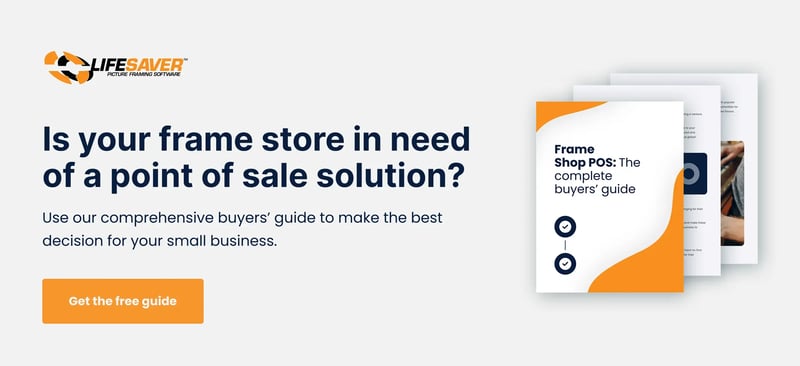
Custom framing involves a mix of design work, materials, and labor, but not every part of the job pays the same. Some services leave plenty of room for markup. Others take more time than they’re worth.
To increase your framing profit margins, you need to know which services bring in the most revenue and how to quote them effectively. While your store may rely on gross margins between 55% and 65%, not every service contributes equally to that range.
Explore which services improve your bottom line and how modern framing tools help you track materials, organize work orders, and price each job more accurately.
Understanding Framing Profit Margins
Your framing profit margin is the difference between what a work order costs (materials, labor, and overhead) and what you charge. In custom framing, volume matters less than value. You’re not pushing out bulk goods — you’re creating one-of-a-kind pieces.
That means pricing needs to reflect craftsmanship. Customers often expect to pay more for custom work, especially if it involves specialty materials or skilled design. According to recent data, they’ll spend up to 17% more on handmade or artisanal items.
Busy weeks won’t boost profits unless your pricing reflects your process.
Which Services Have the Highest Profit Margins?
The most profitable framing services are quick to complete or have elevated pricing because of the care and materials involved. Some bring in big returns with minimal materials; others justify a larger total through labor, expertise, or specialty handling.
Here are the services that tend to deliver the best returns.
Conservation Framing
Conservation work brings in some of the top framing profit margins. It uses specialized materials like UV-protective glass, acid-free mats, and archival backings — each with built-in pricing benefits. Museum glass alone can have a 200–300% markup, and conservation mats often raise the total without adding much time to the job.
Customers who choose this service are focused on preserving valuable or irreplaceable pieces. That allows for more flexible pricing and increased order values. These jobs position your work at the upper end of the market, where single projects often generate more revenue per sale.
Canvas Stretching
Canvas stretching requires minimal labor, but it pays well. Most customers bring in rolled canvases without realizing it’s a separate step before framing. Stretcher bars are inexpensive, but the labor — measuring, aligning, stapling, and adjusting — can be charged by the piece or the hour.
Some shops offer it as a flat-rate service, while others fold it into a larger framing order. Either way, it gives you clear pricing control and often leads to upgrades. Once the canvas is stretched, many customers choose floating frames, protective finishes, or full enclosures, turning a low-cost service into a big-ticket job.
Dry Mounting
Dry mounting is a quick, high-margin service that works well for posters, large photos, and commercial pieces. It stabilizes the artwork by permanently adhering it to a backing board, usually within 30 minutes with a commercial press. The material cost is low, but customers pay $15 to $30, depending on size.
It’s an easy service to batch and especially useful during event seasons or for corporate clients ordering in volume. While less visible than a full frame, it adds value by preventing warping and buckling. This one delivers if your shop needs small, repeatable jobs to fill the schedule and boost cash flow.
Shadowbox Framing
Shadowboxes can be time-intensive, but they deliver some of the largest returns in the shop. These jobs typically involve multiple services — mounting, specialty fitting, deeper mouldings, and sometimes premium glass. Customers will pay more to preserve something personal, like medals, wedding keepsakes, or heirlooms. That emotional value makes the total easier to quote at a premium price point.
With the right build, shadowboxes can increase profit margins by up to 500%. If you’re looking for high-dollar work that justifies the time, this is it.
Specialty Fitting
Fitting is where frames come together — cutting moulding, joining corners, installing glass, mounting the art, and sealing the back. Standard fitting might take about 45 minutes, but more complex builds — like fillets or multilayer mats — can take up to two hours. Labor is typically billed at $60/hour.
This is often one of the most overlooked ways to increase net profit margins because it feels part of a standard work order. But when framed as a service, it becomes an easy way to charge for your time. It also helps you protect your margins on jobs that use less expensive materials but require more skill or hands-on work.
Rush Services
Rush orders allow you to charge more without changing the materials. Whether it’s a same-day photo gift or a last-minute graduation frame, urgency has value. A rush fee — flat or hourly — helps prioritize these jobs without disrupting your schedule. You’re charging for speed, rearranging workflow, staying late, or bumping another job.
Many customers will happily pay for a guaranteed turnaround when there’s a deadline involved. It’s a simple add-on that doesn’t require more product or extra space — just a clear policy and a set price. Over time, those fees can add up fast to increase profits.
Tools To Track and Improve Profit Margins
Improving your framing profit margins starts with knowing which jobs pay off — and which don’t. Modern point of sale (POS) tools give you a clear view of how each service performs over time, so that you can price based on real data, not guesswork.
The right system helps you:
-
Break down profit by service: View earnings by service type — like shadowboxes, canvas stretching, and conservation framing — to see which jobs deliver the best return. Focus your time and pricing strategy on the services that consistently drive revenue.
-
Compare material use across orders: Track the cost of materials used in each service, like glass, matboard, and mounting supplies. Some premium jobs may seem profitable until you factor in how much inventory they consume.
-
Review job history by type: Look at how often you sell certain services, the average order value, and any seasonal patterns. This helps you decide what to feature, what to bundle, and what may need a pricing reset.
-
Access real-time vendor pricing: Check material costs from trusted vendors as you quote, so you can uncover savings or choose when to offer premium options. Knowing what you pay before the order goes in helps protect your margin on every job.
With LifeSaver POS, you can quote, track, and assess every job in one place to base quotes on your shop’s data.
Increase Your Framing Profit Margins on Every Sale
Improving your framing profit margins comes down to understanding where your time and materials go, and adjusting prices to match the service. LifeSaver POS gives you the tools to manage pricing and margins.
With integrated quotes, job tracking, and sales reports, you can see which services deliver the best return and where prices need adjusting. Accurate data makes creating fair pricing strategies that yield profits easier.
Get your copy of The Complete Buyer’s Guide — and start pricing smarter, selling better, and improving your bottom line.

Jul 8, 2025 4:28:20 PM








